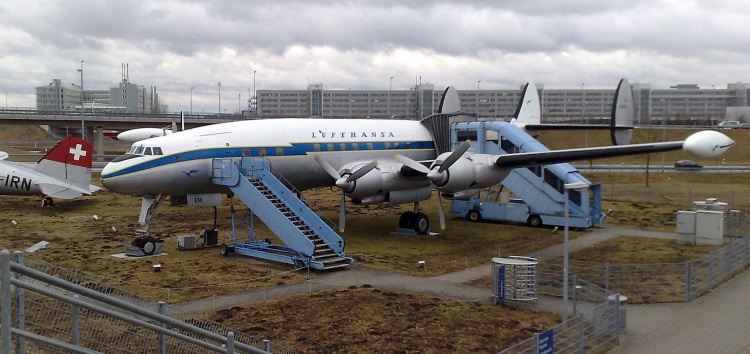
On Sat. 2nd Feb. 2008, I visited the Besucherpark(Visitor Park) in Flughafen München(Franz Josef Strauss International Airport, Munich), Bavaria, Germany
and took a close look at a Super Connie.
Took the following photos of the Lockheed Super Constellation -- one of my favorite piston-engined propeller-driven airliners.
|
Lockheed Super Constellation L.1049G, constr. no:4671.
[Image info:
Nokia N82,
with Carl-Zeiss Tessar 5.6mm f/2.8
(35mm FX equiv.: 28mm) lens, |
The chronologically closest Air-India aircraft was a Lockheed Super Constellation L.1049G c/n:4613, named "Rani of Nilgiris", registered as VT-DHL.
Rani of Nilgiris was sold to the Indian Air Force as BG-580, resold to the Indian Navy as IN-317 and eventually scrapped by the Indian Navy.
|
Right three-quarters view of the old bird -- one of the most elegant aircraft to ever grace the skies!!.
[Image info:
Nokia N82,
with Carl-Zeiss Tessar 5.6mm f/2.8
(35mm FX equiv.: 28mm) lens, |
Why did the Connie have three vertical stabilizers?
So that they could get it into the low roof hangars in the 1950s, without compromising tailfin surface area.
Had the Connie had a single vertical stabilizer, it would not have fit into any of TWA's hangars. So it was designed with three vertical stabilizers, which could split the surface area amongst themselves.
The three tailfins were barely 24 feet 9 inches above the ground.
Compare that to today's Boeing 747 with a vert. stab. that's 63 ft. 8 in. tall.
And the new Airbus A380 with a 79 ft. tall tailfin.
Why did the Connie have such a tall undercart?
The enormous fifteen foot propellers, required an unusually tall undercarriage for adequate ground clearance.
|
A plaque fixed in front of the nose wheel states: "With the Lockheed L-1049G Super Constellation, Registration D-ALEM, Lufthansa of Germany started on 8th June 1955, their first Intercontinental flight from Hamburg to New York. Flight time: 17 hours.".
[Image info:
Nokia N82,
with Carl-Zeiss Tessar 5.6mm f/2.8
(35mm FX equiv.: 28mm) lens, |
|
First class was in the rear (aft) portion of the Super Constellation -- the quietest section of the fuselage.
[Image info:
Nokia N82,
with Carl-Zeiss Tessar 5.6mm f/2.8
(35mm FX equiv.: 28mm) lens, |
|
The Super Constellation has been cleaned, painted. The cabin is outfitted with two video monitors that continuously play a Lufthansa movie on the days of the Super Constellations. The cabin looks roomier (reduced tube-effect) because the overhead drop-down beds have been removed.
[Image info:
Nokia N82,
with Carl-Zeiss Tessar 5.6mm f/2.8
(35mm FX equiv.: 28mm) lens, |
Curtiss-Wright R-3350 Turbocompound engines
Each Curtiss-Wright R-3350 Turbocompound on the Super Connie had 18-cylinders arranged in two-stars
and equipped with 3 exhaust gas power recovery turbines (PRTs).
These PRTs, were geared to the engine crankshaft by fluid couplings to boost power.
The PRTs recovered about 20 percent of the exhaust energy (around 450 hp) that would have otherwise been wasted.
With the turbocompound boosted power, each engine developed 3,250 shp.
|
Curtiss-Wright R-3350 Turbocompound engines
[Image info:
Nokia N82,
with Carl-Zeiss Tessar 5.6mm f/2.8
(35mm FX equiv.: 28mm) lens, |
|
Curtiss-Wright R-3350 Turbocompound engines
[Image info:
Nokia N82,
with Carl-Zeiss Tessar 5.6mm f/2.8
(35mm FX equiv.: 28mm) lens, |
|
View of the port wing.
[Image info:
Nokia N82,
with Carl-Zeiss Tessar 5.6mm f/2.8
(35mm FX equiv.: 28mm) lens, |
Cockpit
Super Connies had a crew of five:
|
Cockpit
[Image info:
Nokia N82,
with Carl-Zeiss Tessar 5.6mm f/2.8
(35mm FX equiv.: 28mm) lens, |
The L.1049 were the first aircraft equipped with a flight director, ILS Zero-Reader and a failure analyzer (CRT engine vibration and sparkplugs), which allowed for detecting dysfunctional plugs.
Much after ILS was introduced, glidepath and glideslope were shown on an indicator with two ILS needles (one vertical and one horizontal).
Heading and altitude were corrected with tiny aileron and throttle adjustments, to keep both needles centered, staying precisely on the indicated glide slope (vertical path indicated by horizontal needle) and glide path (horizontal path indicated by vertical needle).
|
Cockpit
[Image info:
Nokia N82,
with Carl-Zeiss Tessar 5.6mm f/2.8
(35mm FX equiv.: 28mm) lens, |
Eclipse-Pioneer PB-10 autopilot
The Eclipse-Pioneer PB-10 analogue electronic autopilot (by Bendix of Teterboro, NJ) maintained altitude and airspeed by automatic control of the elevators and throttles.
Amplifiers drove aileron, rudder and elevator servo motors.
Modern airliners today, of course, have fully digital flight control systems.
|
Autopilot
[Image info:
Nokia N82,
with Carl-Zeiss Tessar 5.6mm f/2.8
(35mm FX equiv.: 28mm) lens, |
Control Cables
Back in 1955, physical cables from the flight-deck operated the aircraft's control surfaces, throttle, mixture, propeller-pitch,...,
Routed over pulleys!
This was not unlike the brake cables and throttle cable of a motorcycle.
Modern aircraft of course, are increasingly fly-by-wire!
|
Control Cables
[Image info:
Nokia N82,
with Carl-Zeiss Tessar 5.6mm f/2.8
(35mm FX equiv.: 28mm) lens, |